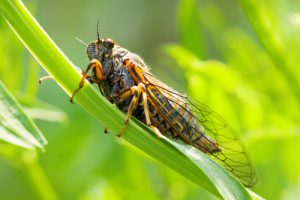Listen for the Cicadas
Views: 5875

Oh boy, is my mom lucky. It sounds like the 17-year cicadas are set to arrive on her birthday, May 23, and they’re most likely to peak around Memorial Day weekend in Northeast Ohio. This noisy onslaught of flying and crawling insects is supposed to make a grand entrance just in time for multiple festivities.
Cicada lifecycle
Cicada are in the Hemiptera family like leaf hoppers, but they have a very different lifecycle. They begin, like most, as a small egg that the female lays in the grooves of branches. It looks like a tiny white ant as it sucks the fluids from the tree. After some time, it will eventually drop to the ground and dig down into the soil where it will feed upon tree roots for years. This is where they’ve been for over a decade in Ohio and in many parts of the East.
Now that their time is right and the soil is finally warming up, the nymphs will emerge from the ground and head back up into the trees where they’ll shed their exoskeleton and start their search for a mate. Cicadas are known for their unique sound, which is the male making sounds to attract the females who respond by clicking their wings. The result is quite the cacophony reaching upwards of 90 decibels.
Are cicadas poisonous?
Cicadas aren’t poisonous, but you’ll have to watch your pets if they have a penchant for eating things. Wings can cause choking problems, plus if they eat too many they can come back up. So try to keep cats and dogs away from groups of them where they might be tempted to snack. (I know cats have great fun with them, but it’s totally gross to hear them crunching on cicadas.)
While the numbers of cicadas can be rather daunting, the good news is they don’t have chewing mouthparts so they really can’t do any damage to your trees or the garden. The females will look for branches to lay their eggs, though. But while your landscape is safe, it’s still going to get messy. Cicada adults live to mate and die, which isn’t very fulfilling if you’re going to take 13 to 17 years to make your presence known. The bad thing is the rotting little cicada bodies can pile up and stink. If you have a lot of them in an area, you might have to scoop them up with a shovel. I’ve also heard recommendations to dump their little carcasses in the compost pile, and I don’t see any reason why not.
Emergence
And, if you want to be part of the cicada watch, be sure to report your sightings at Magicicada at http://magicicada.org/report/report.php. This helps experts keep track of where they’re emerging and their lifecycle process.
The cicadas emerging isn’t an event that happens every day, or every year for that matter. While they might be bothersome for a short amount of time, they won’t last that long. Plus, unlike aphids or Japanese beetles, cicadas don’t keep coming back at you to make your life difficult.
Since we don’t have cicadas in our area, the beautiful photo is by Anton Kozyrev through shutterstock.com.
Meet Amy Grisak
Amy is a freelance author and photographer in Great Falls, MT who specializes in gardening, foods, and sustainable agriculture. She provides information on every kind…
Amy's Recent Posts

This Little Piggy is a Problem: Dealing with Feral Hogs








